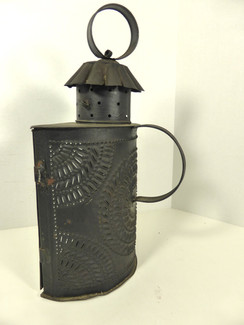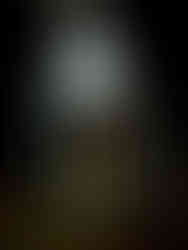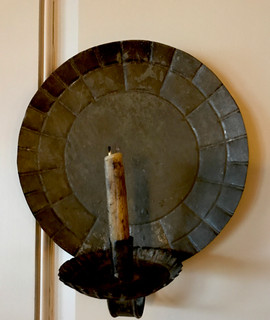Lighting Up the Dark
- Carole Conn
- May 30, 2017
- 4 min read
Updated: Dec 12, 2019

Our colonial settlers built houses with few windows and doors in order to keep the heat from the fireplace inside. This made for very dark houses! Until Thomas Edison's invention of the electric light became available and affordable, bringing light into a building's interior was always a challenge.
Most collectors of early country antiques eventually focus on lighting devices and tools because they were critical everyday items in our ancestors' lives. And they are so interesting!
Think about it.... the winters were long, cold and dark. With no lights, houses were places where you couldn't see to do much, especially at night. So how did they cope?
Candles were for rich people, at least in the 1700s and early 1800s. They were expensive to buy, didn't burn for very long, and they were time-consuming to make.

You had to have a fire burning in the fireplace all the time, even in the summer, for cooking, if not for warmth. This was the only source of light in most homes. If you wanted to go into another room, or outside, you needed a portable light source. If you couldn't afford candles, and most couldn't, you had to burn pieces of rush which could be placed in a rush holder - a precursor to candlesticks.
Rush stalks were gathered in the fall. The green rind of each stalk was peeled off to reveal the inner pith. After drying, the rush was steeped in available household fat or grease.
But you had to be quick - a 12 inch piece of rush would only burn for 10-15 minutes!
Rush holders are available in the marketplace, and interesting to collect today. They tend to be expensive, though - over $200, and sometimes much more. They can't really be used, but they look good.


Oil lamps burned longer. But they really smelled bad! The primary oils used before the widespread availability of whale oil were fish oil and household grease. They were also smoky and dangerous. Burning oil caused many a house fire. Before whale oil was around, simple spout betty lamps and the cruise lamps were the only oil lamps which were readily available.
In the 1700s and early 1800s candles were the best option for interior light. Candles were very expensive and not easy to make. Most households had only one or two candle sticks for that reason. Candles were burned for short periods of time, and only when necessary.
Because they were expensive to buy, most households made their own candles from tallow or animal fat. The earliest method of making candles was by dipping them.

A cotton wick was tied to a rod or stick and dipped into melted tallow repeatedly, drying between dips, until a candle was formed.
They didn't burn very well, were pretty smelly, and the light was poor.
Beeswax made good smelling candles, but beeswax was expensive to buy. Those who could, kept bees for that reason.
The settlers in Massachusetts found that they could make a sweet smelling wax from bayberries. It took roughly 15 pounds of bayberries to produce only one pound of wax, so they were very expensive to make or buy. Bayberry candles are still available and sought after.
When whaling became an important industry in the late 1700s, whale spermaceti which was a waxy substance from the whale's head, was found to make superior candles which burned longer, brighter, didn't smell bad, and didn't melt in the summer.
Making candles in candle molds was easier and more efficient than the dipping method. Because of the mold, these candles were more uniform in shape and burned better. They could also be made more quickly. Most villages of any size had candle makers who sold their candles to the residents.

Antique candle molds are readily available today and fun to collect. I have seen

everything from a single candle mold to one with space for 40-50 candles. Some people make lamps out of antique molds, but I've never been a fan of that. You can use the standing ones as a sort of a primitive candelabra! Having a couple around provides "atmosphere" and maybe the temptation to try your own candle making.
With the increased availability of whale oil, many whale oil burning lamps were designed and made, starting in the 1800s. Their sizes, shapes, number of burners, style and design are varied. So varied, and so interesting, that they will be the subject of another blog at a later date.
A word about lanterns used the 18th and early 19th centuries: a very popular and collectible lantern is the "Paul Revere" lantern which is made of rolled iron and has punched decorations all over it to emit light from the candle. It had no glass at all. It is very doubtful that Paul actually used this type of lantern during his famous ride, though. It emits very low light.

It was made this way primarily for safety. There is no glass to break if the lantern is knocked over in a barn, causing hay to ignite. Revere lanterns are readily available today and good ones start around $200. Look for candle sockets that are cleated through the bottom of the lantern. If there is no cleat the lantern is later - probably after 1850. Intricate punched designs and fine punching increases the value of these lanterns.
There are many types and varieties of candle lanterns. The wooden "barn lantern" that you often see in sales is almost always of European origin, although there are American ones, but they are rare.

When you are looking for an antique lantern for your collection, look for hand crafting. There are lots of machine made lanterns dating from the later 1800s, but the country craftsman's lantern is always more interesting and usually more appealing. If the lantern has glass, look for bubbles and ripples in it which indicates that it is old glass. There are so many types and styles that collecting them is really fun.
Candle sconces are another very collectible and useful lighting category. They also come in many forms and good early ones can be found for just over $100 in some cases. Again, look for hand crafting, cleated candle sockets, usefulness.
Styles and types of lighting devices vary widely. I guess the best advice is to buy what you love, rely on the advice of trusted dealers, and try to find the purest, and the earliest you can afford. Happy hunting!

Carole Conn
SaveSaveSave




























